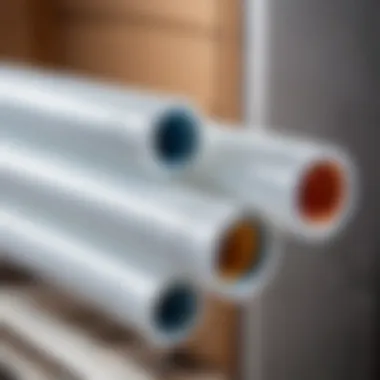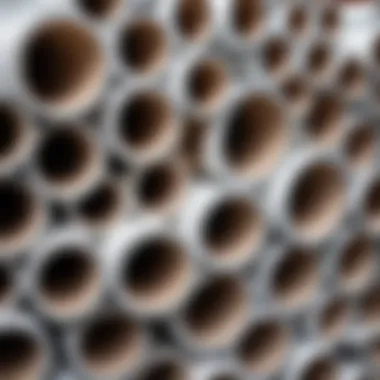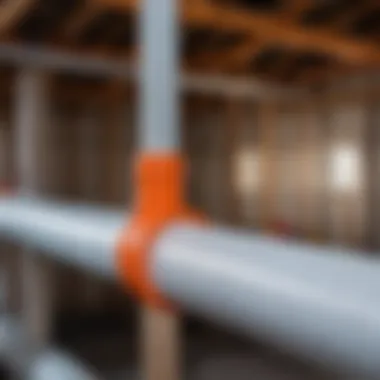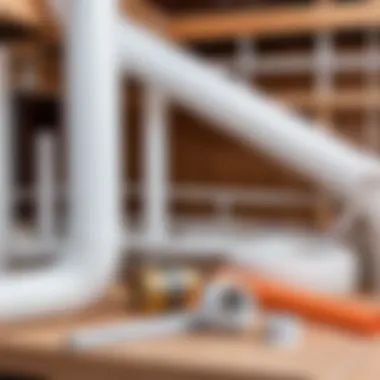Insulating Polypropylene Pipes: Techniques and Best Practices


Intro
Proper insulation of polypropylene pipes is a vital aspect of modern plumbing. Given the progressive nature of home improvement projects, understanding how to effectively insulate these pipes can lead to better temperature regulation and increased energy efficiency. This article serves as a guide, not just for seasoned professionals but also for DIY enthusiasts. Both groups will benefit from detailed insights about insulation materials, application methods, and important considerations for effective implementation.
Проектирование и планирование
When planning a project involving the insulation of polypropylene pipes, clear design and preparation are crucial. A thoughtful approach ensures that resources are utilized effectively, and the potential for mishaps is minimized.
Как выбрать проект для DIY
Choosing the right project can feel overwhelming at first. Consider starting with manageable sections within your plumbing system. Focus on areas that are prone to fluctuations in temperature, such as basements or unheated spaces.
Once you've identified such areas, you should sketch out a plan, marking the specific pipes that need insulation. A well-drafted blueprint can also help in calculating the quantities of materials required. This planning stage can save time and effort down the line.
Оценка времени и ресурсов
Estimating the time and resources needed for your project is essential. An effective strategy includes breaking down the tasks into smaller segments and assigning realistic time frames for each. Generally, it might take a few hours to a weekend to insulate a moderate section of piping, depending on the complexity.
As for resources, having the correct tools on hand is important. A measuring tape, utility knife, and appropriate adhesives or fasteners are some basics you should gather beforehand. Proper assessment can prevent delays and allow you to focus on the task at hand.
Выбор материалов
The choice of materials plays a significant role in the insulation process. Several factors dictate what materials are most suitable for your specific project needs.
Типы материалов для различных проектов
Polypropylene pipes generally require insulation materials that can handle their unique properties. Foam pipe insulation, fiberglass blankets, and reflective foil are among the commonly used types. Each material type has its advantages and can be chosen based on your specific insulation goals. For instance, foam insulation is easy to apply and effective in many settings, while reflective foil is excellent for high-temperature applications.
Советы по покупке и экономии
When it comes to purchasing insulation materials, consider bulk buying for cost savings. Local hardware stores often have sales, so keep an eye out for discounts. Additionally, examining online suppliers can reveal competitive pricing options.
Take the time to review product specifications to ensure that the materials chosen are appropriate for your pipe types and will serve long-term durability. Always choose quality over price since the performance of the insulation directly impacts energy efficiency and the lifespan of your plumbing system.
Remember: Selecting the right materials and planning methodically is key to a successful insulation project. It not only saves time but also ensures a more effective overall outcome.
Understanding Polypropylene Pipes
Understanding polypropylene pipes is fundamental for anyone involved in plumbing and pipe insulation. Polypropylene is a thermoplastic polymer known for its versatility and resistance to various chemicals. This makes it an excellent choice for piping applications in residential and industrial settings. By grasping the characteristics and applications of polypropylene pipes, one gains insight into their benefits and optimal uses.
Characteristics of Polypropylene
Polypropylene pipes have various distinguishing features. They are lightweight yet strong, which simplifies installation. The flexibility of polypropylene also contributes to its strength, allowing pipes to bend without breaking. Furthermore, these pipes resist corrosion and scaling, making them a preferable option in many plumbing systems. They can handle both hot and cold water, which broadens their utility in various settings, from residential homes to commercial buildings. Their shinier surface helps in maintaining flow rates, reducing friction as liquid moves through.
Some key characteristics include:
- Chemical Resistance: Polypropylene is resistant to many acids, bases, and organic solvents.
- Thermal Stability: It can operate at temperatures as high as 80 °C without deforming.
- Low Density: They are much lighter compared to traditional materials like copper or PVC, leading to lower shipping costs and easier handling.
Common Applications in Plumbing
Polypropylene pipes have gained popularity in various plumbing applications thanks to their characteristics. They are often used in:
- Hot and Cold Water Supply: Their ability to operate under various temperatures makes them suitable for both hot and cold water systems.
- Radiant Heating Systems: Polypropylene's thermal properties allow for efficient heat distribution in floor heating systems.
- Drainage Systems: Their smooth interior surface helps prevent clogs, making them ideal for drain and vent systems.
This understanding extends beyond merely knowing the material. It helps in recognizing how insulation techniques enhance the already beneficial properties of polypropylene pipes, ultimately improving the efficiency and longevity of plumbing systems.
Importance of Insulation
Insulation plays a crucial role in the performance and efficiency of polypropylene pipes. It helps mitigate temperature fluctuations in plumbing systems, safeguarding against high energy costs and maintaining consistent water temperatures. Understanding the significance of insulation can lead to more efficient plumbing projects, whether for residential or commercial uses.


One of the primary considerations in insulation is energy efficiency. When pipes are properly insulated, they help minimize heat loss. This is particularly important in hot water applications, where uninsulated pipes result in a substantial loss of heat, necessitating more energy to maintain desired water temperatures. Reducing such losses can dramatically cut operational costs, making insulation not just an additional feature but a necessary investment.
Another vital aspect is preventing condensation buildup on pipes. In environments where temperature differences between the water in the pipe and the surrounding air are significant, condensation can occur. This moisture accumulation can lead to dripping and further complications such as mold growth or structural moisture damage. Good insulation will maintain the surface temperature of the pipe above the dew point, effectively preventing condensation.
Finally, insulation contributes to extending the lifespan of polypropylene pipes. High and low-temperature extremes can compromise pipe integrity over time, leading to cracks and failures. Insulating pipes shields them from rapid temperature changes and protects the materials from external environmental factors that may accelerate wear and tear. Thus, insulation not only ensures effective plumbing performance but also enhances the overall durability of the system.
Key considerations regarding insulation include:
- Energy efficiency savings
- Prevention of condensation-related damage
- Lifespan extension of plumbing materials
In essence, insulation is not just an afterthought in pipework; it is fundamental to enhancing the overall functionality and longevity of plumbing systems.
Insulation Materials for Polypropylene Pipes
The insulation materials chosen for polypropylene pipes play a crucial role in achieving energy efficiency and extending the lifespan of plumbing systems. Various materials offer distinct properties that can be pivotal in addressing the specific insulation needs of these pipes. Understanding the options available can aid in making an informed choice that balances performance, cost, and practicality. Below are some of the most common insulation materials used for polypropylene pipes.
Foam Insulation
Foam insulation is widely recognized for its effectiveness and flexibility in a range of plumbing applications. There are two primary types of foam materials utilized: closed-cell foam and open-cell foam.
Closed-cell Foam
Closed-cell foam is a strong contender in the insulation market due to its superior resistance to moisture and vapor. This characteristic makes it particularly beneficial for applications where water exposure is a concern. The key feature of closed-cell foam is its dense structure, which creates individual cells that do not allow air or moisture to pass through easily. This feature minimizes heat loss, enhancing overall energy efficiency.
In this article, closed-cell foam is endorsed for its high durability, resistance to compression, and relatively low thermal conductivity. The unique feature of this foam type is its ability to provide excellent insulation while also serving as a barrier against external factors such as moisture and pests. However, it is often more expensive than other insulation materials, which may be a consideration in budget-sensitive projects.
Open-cell Foam
Open-cell foam, while not as moisture-resistant as its counterpart, still holds a significant place in insulation practices. The primary characteristic of open-cell foam is its lighter density, which allows for high levels of airflow. This characteristic is often seen as beneficial for applications where ventilation is important, such as in certain plumbing setups.
Open-cell foam offers excellent sound insulation properties and is often more cost-effective than closed-cell options. The unique aspect of open-cell foam lies in its flexibility, making it easier to cut and fit around pipes. However, one must be cautious about its lower thermal insulation performance compared to closed-cell foam, especially in humid or damp environments. This could potentially lead to higher energy costs if not accounted for.
Fiberglass Insulation
Fiberglass insulation is another popular choice for insulating polypropylene pipes. It consists of tiny glass fibers, which create a network that effectively slows down heat transfer. Fiberglass is known for its versatility and is available in a variety of forms, such as batts, rolls, or loose-fill. The material is lightweight, making it easy to handle and install.
One of the significant benefits of fiberglass insulation is its cost-effectiveness. It is generally cheaper than other insulation materials while still offering good thermal performance. However, poor installation can diminish its effectiveness. Using fiberglass insulation requires careful fitting around pipes and joints to prevent air leaks that can compromise energy efficiency.
Reflective Insulation
Reflective insulation functions differently from traditional insulation materials. Instead of trapping air pockets to resist heat flow, reflective insulation utilizes reflective surfaces to redirect radiant heat. This type of insulation is particularly effective in warm climates where heat gain is a concern. By reflecting radiant heat away from the pipes, it helps maintain cooler temperatures within the plumbing system.
The main advantage of reflective insulation is its ability to reduce cooling costs in hot environments. It's lightweight and easy to install, making it a popular choice for residential and commercial plumbing systems. However, its effectiveness is diminished in colder conditions, meaning it might not be ideal for every climate.
Mineral Wool
Mineral wool, also known as rock wool, is made from natural minerals or recycled materials. This material is highly fire-resistant, which is an essential factor for insulating plumbing in certain applications. Like fiberglass, mineral wool provides excellent thermal and acoustic insulation, making it suitable for pipes that might generate noise.
The outstanding feature of mineral wool is its resistance to moisture, which helps prevent the growth of mold and mildew. This can be particularly advantageous in plumbing systems that may face condensation issues. However, mineral wool can be denser and more expensive than other insulation materials. It may require additional support during installation to ensure a secure fit around the pipes.
Preparation for Insulating Polypropylene Pipes
Preparing for the insulation of polypropylene pipes is a crucial step in ensuring effective temperature regulation within plumbing systems. This preparation phase involves understanding both the specific configuration of the pipes being insulated and the characteristics of the selected insulation material. Proper preparation can lead to improved energy efficiency, reduced risks of condensation, and a overall better performance of the plumbing infrastructure.
Assessing Pipe Configuration
Before any insulation is applied, it is essential to assess the configuration of the pipe layout. Different setups, such as horizontal and vertical pipes, require varied approaches to insulation. The diameters, lengths, and proximity to heat sources or cold environments must be noted. Critical areas include bends, joints, and fittings that may need special attention during the insulation process. Careful evaluation will help ensure that the insulation is correctly fitted and that there are no gaps that could lead to heat loss or condensation.
- Evaluate pipe location and accessibility
- Identify bends, joints, and attachments
- Consider environmental factors influencing pipe temperature
This thorough assessment is beneficial in avoiding insulation coverage gaps and enhancing the overall effectiveness of the insulation applied.


Choosing the Right Insulation Material
Selecting the appropriate insulation material is vital for optimizing energy efficiency and ensuring that the insulation meets the specific needs of the plumbing system. Various insulation materials possess unique properties, which can affect their performance. Factors to consider include thermal resistance, moisture resistance, and installation ease. It is also important to match the insulation type to the conditions in which the pipes operate.
For example:
- Foam insulation offers flexibility and ease of installation.
- Fiberglass insulation provides excellent thermal resistance and is a common choice.
- Reflective insulation is useful in hotter climates to minimize heat gain.
- Mineral wool can withstand high temperatures and is beneficial in high-heat environments.
Evaluating the above characteristics will ensure that the materials selected are aligned with the intended performance goals for the insulation process.
Safety Considerations
Safety should always be a top priority during the insulation process. Polypropylene pipes, while generally safe to handle, can present challenges if proper precautions are not taken. Therefore, it is critical to follow established safety protocols which include the use of personal protective equipment (PPE).
Proper attention to safety can reduce risks associated with insulation installation, such as potential cuts or exposure to harmful materials. Before embarking on the insulation task, ensure the following:
- Wear gloves, eye protection, and a mask if working with materials that generate dust.
- Ensure proper ventilation when using adhesive products or chemicals.
- Follow manufacturer guidelines for installation materials to prevent chemical reactions.
By addressing these safety considerations, individuals can minimize risks and enhance efficiency during the preparation phase of insulating polypropylene pipes.
"The foundation of effective insulation begins with proper planning and preparation."
In summary, preparing for the insulation of polypropylene pipes involves assessing the configuration, selecting the right materials, and prioritizing safety. By focusing on these key elements, one lays the groundwork for a successful insulation process.
Application Techniques for Insulation
The process of insulating polypropylene pipes is crucial to enhance the efficiency and longevity of plumbing systems. Proper application techniques not only optimize energy usage but also prevent potential damage from temperature fluctuations. This section outlines key methods and considerations that contribute to effective insulation practices, ensuring both professionals and DIY enthusiasts can achieve high-quality results in their projects.
Cutting and Fitting Insulation
Cutting insulation properly is one of the first steps that can significantly influence the final effectiveness of the insulation. Precise measurements are critical. When measuring, ensure to account for any bends or fittings in the piping. If insulation does not fit snugly around the pipe, it can result in gaps, reducing thermal efficiency. Tools such as utility knives or hot wire cutters can be used to achieve clean cuts.
Once the insulation material is cut to the required length, fitting is the next step. The insulation should wrap around the pipes without any overlaps that would create unnecessary bulk. It is important to check that each section fits tightly together, especially in joint areas. This prevents thermal bridging, which can occur if insulation does not completely cover the pipe's surface.
Securing Insulation in Place
Securing insulation is essential to maintain its position over time. If insulation becomes loose, it can expose pipes to temperature extremes and moisture buildup. Various methods are available to secure insulation effectively.
- Tapes: Use foil or PVC tape to ensure seams are tightly closed. This will help in minimizing heat loss.
- Straps or Bands: For larger pipes and insulation types, employing straps can keep insulation firmly held in place.
- Spray Adhesives: These adhesives are effective for bonding insulation to irregular surfaces.
It is advisable to follow the manufacturer's instructions on securing methods for the insulation type being used. This can improve the overall performance and longevity of the insulation.
Installing Vapor Barriers
Installing vapor barriers is crucial in reducing moisture migration within insulated areas. Vapor barriers help prevent condensation that can lead to mold and other moisture-related issues. They should be installed on the warm side of the insulation, which means placing them toward the interior of a building during colder months.
Material choice for vapor barriers varies. Common options include polyethylene sheeting or specialized vapor barrier films. When installing, ensure:
- All seams are sealed with appropriate tape.
- The barrier overlaps any openings or edges securely.
- Special care is taken around junctions where pipes exit through walls.
Adhering to these practices will help maintain dry conditions around insulated pipes, contributing to the overall effectiveness of the insulation system.
Proper application techniques for insulating polypropylene pipes are essential to ensure the longest life and maximum efficiency of plumbing systems.
Ensuring correct application techniques not only benefits the immediate installation but also influences long-term maintenance and efficiency in plumbing infrastructure. As systems age, following best practices during insulation can prevent significant issues down the line.
Common Mistakes in Pipe Insulation
Understanding common mistakes in insulating polypropylene pipes is crucial. Proper insulation enhances energy efficiency and pipe longevity. Neglecting certain aspects can lead to increased energy costs and potential damage. By identifying and correcting these common pitfalls, one can ensure optimal functionality of the plumbing system.
Over Insulating Pipes


While insulation is necessary, over insulating can cause problems. Too much insulation can trap heat and dampness. This creates an environment conducive to mold and mildew growth. It also increases material costs unnecessarily. The key is to insulate just enough to achieve balance. The appropriate thickness of insulation material depends on various factors, including local climate and energy usage. It's important to follow manufacturer guidelines to avoid excessive insulation, which can undermine the benefits of maintaining consistent temperatures in pipes.
Ignoring Fittings and Joints
Fittings and joints require as much attention as the pipes themselves. These areas are prone to heat loss and condensation. Ignoring them can lead to energy inefficiency and water damage. It's essential to ensure that all joints are properly insulated with appropriate materials. Consider using insulating tape or sleeve insulation for fittings. Inspecting these areas regularly allows for early detection of any issues, preventing larger problems in the future.
Neglecting Maintenance Checks
Regular maintenance is a critical aspect of effective insulation. Neglecting this can lead to unnoticed damage or wear. A thorough inspection should include checking the insulation for any signs of degradation or moisture buildup. Conducting these checks periodically can help identify and rectify problems promptly. Establishing a routine maintenance schedule will ensure that the insulation continues to perform optimally and does not compromise the functionality of the polypropylene pipes.
Regular maintenance checks are vital to maintain the integrity of your pipe insulation and overall plumbing system.
Evaluating Insulation Performance
Evaluating insulation performance is crucial in ensuring that the objectives of insulating polypropylene pipes are met. Proper assessment not only verifies that the insulation materials function as expected but also identifies any areas that may need improvement or adjustment. The benefits of a thorough evaluation process include increased energy efficiency and potential long-term cost savings, which are essential for anyone involved in plumbing or construction projects.
A key consideration is that evaluating insulation goes beyond just checking for visible issues. It involves a systematic approach to understanding how effectively the insulation is performing in various conditions. This reflection focuses on two primary methods: leveraging advanced technologies and maintaining regular upkeep of the insulation system.
Thermal Imaging Technology
Thermal imaging technology serves as a revolutionary tool in assessing insulation performance. This technology utilizes infrared cameras to detect temperature differences along the insulation surface. By identifying cooler areas, professionals can pinpoint sections where heat loss occurs. Using thermal imaging can significantly decrease inspection time while increasing the accuracy of the evaluation process.
"Thermal imaging allows for a non-invasive examination of insulation systems, ensuring that interventions are targeted efficiently."
Some benefits of using thermal imaging include:
- Quick Detection: Problems like gaps or weak spots in the insulation can be identified swiftly.
- Informed Decisions: Data collected through thermal imaging empowers professionals to make educated choices regarding repairs or upgrades.
- Cost-Effective Measures: Fixing issues early on can result in substantial savings later.
Adopting thermal imaging as a standard practice can transform the way insulation is evaluated, making it an indispensable technique for maintenance and reliability.
Regular Inspection and Upkeep
The practice of regular inspection and upkeep cannot be understated when it comes to maintaining insulated polypropylene pipes. Insulation degradation occurs over time due to environmental factors, wear, or even installation errors. By establishing a routine check-up schedule, potential issues can be caught early, allowing for timely repairs or replacements.
Consider these aspects when planning regular inspections:
- Schedule Frequency: Depending on the environmental conditions, decide on a regular inspection interval — usually once or twice a year.
- Document Findings: Keep a record of observations during inspections to track the insulation's health over time.
- Address Issues Promptly: If problems such as moisture accumulation are discovered, addressing them without delay can prevent further complications.
Incorporating thorough inspections into maintenance protocols leads to prolonged lifespan and enhanced performance of the insulation system.
Future Trends in Pipe Insulation
The landscape of pipe insulation is evolving rapidly, driven by new technology and growing awareness about energy efficiency and sustainability. The trends shaping the future of insulating polypropylene pipes not only enhance performance but also reduce environmental impact. Understanding these trends is crucial for stakeholders in the plumbing and construction industries.
Innovations in Insulation Materials
Recent advancements in insulation technology have led to the development of new materials designed to outperform traditional options. For example, vacuum insulation panels (VIPs) offer superior thermal performance due to their minimal thermal conductivity. Other materials, such as aerogel, are gaining attention for their lightweight and high insulating properties. These innovations can lead to significant energy savings in plumbing systems.
Key benefits of these new materials include:
- Enhanced Efficiency: Modern materials often provide better insulation with thinner profiles, leading to reduced space requirements.
- Longer Lifespan: Advanced materials are typically more durable and resistant to wear, making them suitable for long-term installations.
- Lower Environmental Impact: Many new materials are designed with sustainability in mind, reducing the carbon footprint associated with traditional insulation products.
By integrating such innovative solutions, builders and plumbers can improve system performance while minimizing resource consumption.
Sustainable Practices in Insulation
Sustainability is becoming a crucial focus in pipe insulation practices. As regulations tighten and public awareness increases, adopting sustainable practices is key for future-proofing plumbing systems. This includes using recycled materials, as well as biodegradable options for insulation.
Implementing sustainable practices involves several strategies:
- Material Selection: Choosing insulation materials that have minimal environmental impact and are made from recycled content can significantly enhance sustainability.
- Lifecycle Assessment: Evaluating the environmental impact throughout the entire lifecycle of insulation materials encourages responsible choices.
- Desiging for Reusability: Increasing emphasis on designing insulation for future reuse or recycling can reduce waste.
The transition to sustainable practices is not just beneficial for the environment but can also enhance the public image of businesses in the construction and plumbing sectors.
"The future of pipe insulation lies in effectively balancing performance, sustainability, and cost efficiency. "
In summary, staying informed about innovations and sustainable practices is imperative for professionals in the plumbing industry. Embracing these trends not only supports regulatory compliance but also aligns with a global move toward eco-conscious building practices.







